Traps
|
Traps are important tools for the monitoring and surveillance of adult mosquito populations. Today, various models using different attractants are available – including light, carbon dioxide (CO2), visual cues, animal baits, synthetic lures, or various combinations of the above. Depending on the goal and research question, some models are better suited than others. In virus isolation studies, for example, it will be essential to capture large numbers of the target species. In contrast, surveillance programs require representative samples of the local population, thus relying on more universal traps that attract a variety of species.
|
|
|
Trap development goes back to the early 1900s, when the first (rather unsuccessful) trapping attempts were made using bright light as an attractant and giant fans for capture. Headlee and Mulhern pursued the concept of combining light with suction and developed the first standard mosquito collection device to serve as an alternative for human landing collections: the New Jersey Light Trap (1942). Over decades, variations of this first trap model have been employed; they all use light as an attractant and a fan to draw insects into a holding container beneath the trap (= downdraft technology). The New Jersey Light trap uses a standard incandescent light bulb and requires electrical current from the mains supply to operate the light and fan. Thus, in addition to its weight and bulkiness, the required mains electricity results in the trap usually being placed in one location only.
|
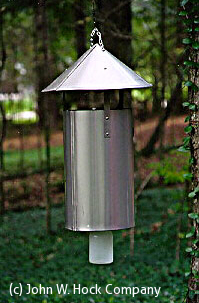
|
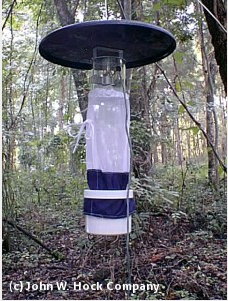
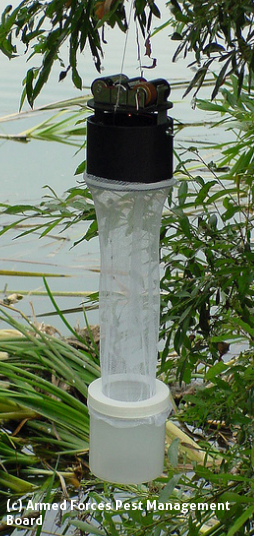
|
Newer models, like the Centers for Disease Control and Prevention (CDC) miniature light trap 1 or the Encephalitis-Virus-Surveillance (EVS) trap, which are powered by batteries, represent more light-weight and easier to transport versions that are widely used in surveillance programs. These traps should be used with dry ice as light alone is a poor and non-selective attractant that can result in the capture of numerous non-target insects like moths and beetles, sometimes in numbers eclipsing those of mosquitoes. Through the addition of CO2, mosquito catch rates can be increased dramatically, while non-target insects will be less attracted. In both models, CO2 is normally dispensed from above the trap using dry ice, although sometimes, the carbon dioxide is also released from gas cylinders. In CDC traps, the dry ice is hung above the trap’s lid, wrapped in newspaper or placed in an insulated container, while the EVS trap comes with an insulated bucket that holds the dry ice. The cold CO2 will continuously sink to the ground until it has completely sublimated. Thus, attracted mosquitoes must fly upwards to the trap opening in order to be sucked into the trap. Orientation towards the trap entry is supported by a small LED light, incandescent light bulbs, or UV-light sources. Here you can find a demonstration of the setup of a CDC miniature light trap.
|
|
CDC and EVS traps work very well with floodwater- and rice field mosquitoes, such as Aedes vexans, Ae. sticticus or Ae. caspius, which usually occur in large numbers and are very much attracted to CO2. They may however not be ideal for the monitoring of anthropophilic and/or invasive species such as Ae. aegypti and Ae. albopictus, a drawback that was already recognized in the 1960s when light and CO2 baited traps were the most prevalent models for monitoring programs. Ovitraps became popular as they allow for an inexpensive, rapid and sensitive detection of Ae. aegypti and Ae. albopictus, with no need for electricity 2. Ovitraps consist of a black (plastic) container filled with water and a wooden sampling paddle or a piece of Styrofoam which serve as the oviposition substrate. Instead of using plain tap water, attraction can be increased through infusions, e.g. oak leaves, grass, hay or alfalfa. In the field, standard ovitraps need to be visited frequently to prevent them from becoming a productive source for adult mosquitoes. This risk has been minimized in a new generation of ovitraps that kill the ovipositing females, inhibit larval development, and allow to collect adult mosquitoes (autocidal/lethal/sticky ovitraps). New and improved gravid trap versions were introduced in 2013 by the U.S. CDC (Autocidal Gravid Ovitaptrap, AGO) 3 and the James Cook University in Australia (Gravid Aedes Trap, GAT) 4 : the AGO has been presented as a low-cost device for the surveillance and control of Ae. aegypti that does not require frequent servicing. The GAT also targets Ae. aegypti and offers another inexpensive and passive method to collect adult mosquitoes that seems to be more effective than the AGO. In Australia, the GAT caught about 2x more adult Ae. aegypti than the AGO (Dr. Scott Ritchtie, unpublished data).
|
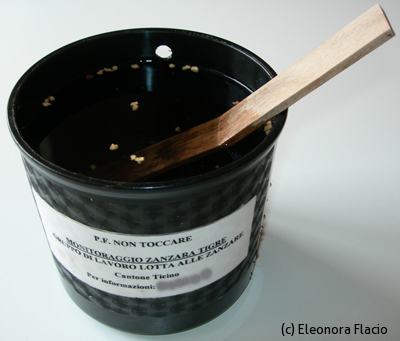
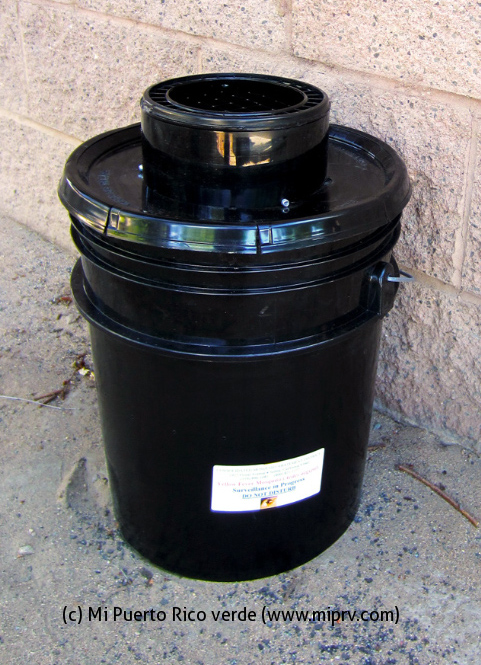
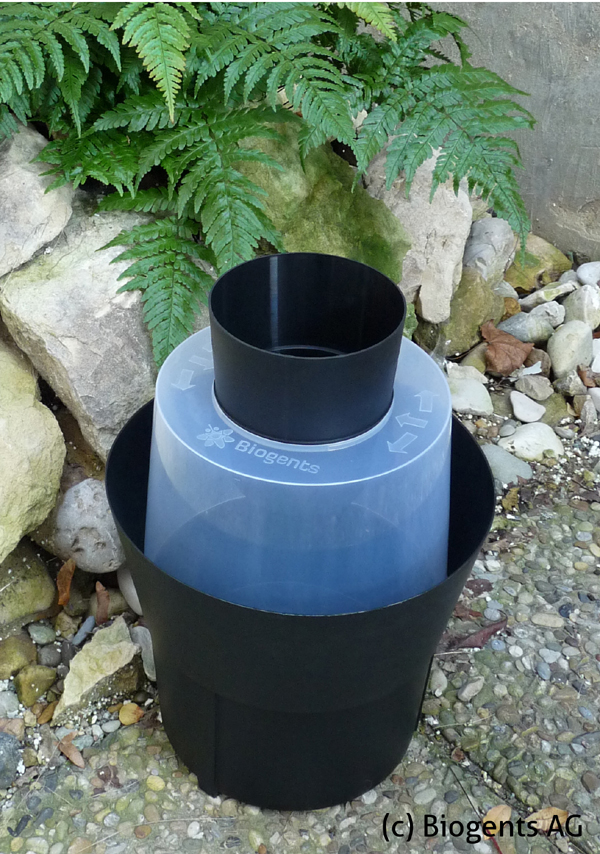
|
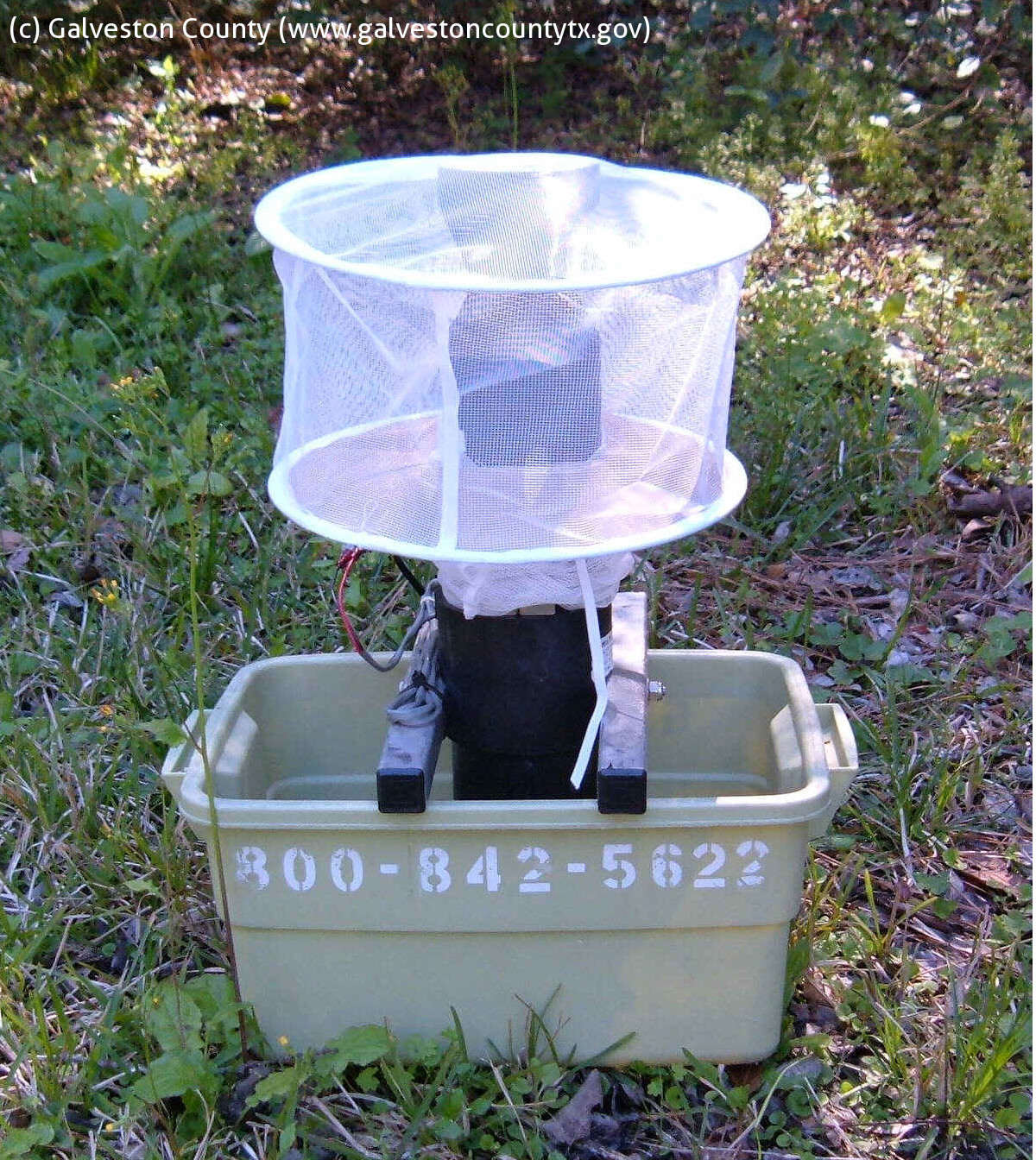
|
Besides passive gravid traps, battery powered models have been developed and employed in arbovirus surveillance studies to actively collect gravid females. The CDC gravid trap 5 consists of a large pan containing an oviposition medium (e.g. hay infusion) that attracts approaching gravid females. The mosquitoes are then collected in a catch bag by an updraft battery operated fan. This trap model has been proven to be very successful in collecting large numbers of gravid Culex females. Here you can find instructions for the setup of a gravid trap.
|
|
Improvement and optimization of trapping systems to monitor the adult population continued and significant progress was made in the late 1990s and early 2000s. To overcome the problem of attracting mosquitoes over the distance (from where they are initially attracted) to where they are eventually collected (like in CDC and EVS traps), American Biophysics Corporation introduced their new counterflow technology which was implemented in a variety of models including the Counterflow Geometry Trap (CFG) 6 and commercially available Mosquito Magnet traps. These models utilize two fans that are integrated in an inner and outer pipe: one fan creates a downdraft in the outer pipe to release a CO2-enriched plume while the second fan creates an updraft in the inner pipe to suck mosquitoes in at the point where CO2 is released. CO2 is either supplied from cylinders of compressed gas or produced by the catalytic combustion of propane, which in addition also generates heat and water vapor. The routine use of CO2 in mosquito surveillance programs can be problematic due to cost and logistics requirements.
|
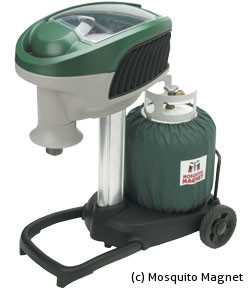
|
|
To address these issues, researchers continued to search for new and better attractants and improved trap designs to provide innovative options for mosquito surveillance and control. Learning more about host-seeking behavior played a prominent role in the optimization process. The mosquito female locates her host through visual cues, heat, moisture and most importantly host-derived odor plumes that represent a strong olfactory cue. Among the approx. 1.400 volatile organic compounds found on human skin and in human breath, only a few have been identified to play key roles in the host-finding process: CO2, lactic acid, ammonia, short chained fatty acids and acetone. In general, a blend of different odors is more attractive than single compounds and most compounds only work as attractants in the presence of lactic acid.
|
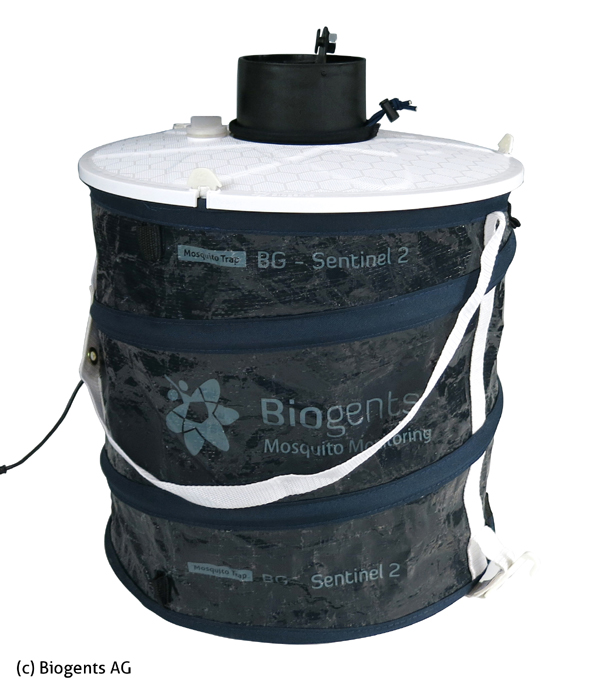
|
In 2006, Biogents AG introduced a novel trapping system for the surveillance of Ae. aegypti: the BG-Sentinel trap (BGS) 7 . The trap utilizes a dispenser that emits an attractive volatile mixture composed of lactic acid, caproic acid and ammonia (BG-Lure, BG-Sweetscent). In combination with the artificial host odors emitted from the dispenser, the BGS uses visual cues and mimics convection currents produced by a human body to create a very attractive target to the host-seeking female mosquito. Here you can find instructions for the setup of the BG Sentinel 2 trap. Initially designed as a sensitive population surveillance tool, the BGS trap has been proven to be superior in catching Ae. aegypti, Ae. albopictus and Ae. polynesiensis, compared to other, currently available trapping devices, even without CO2. When CO2 is added, the BGS functions as a more general mosquito trap and overall catch rates increase.
|
|
Traditionally, control of arthropod mosquito vectors has almost exclusively relied on chemical insecticides, but with growing public apprehension, environmental concerns and developing pesticide resistance, innovative new technologies are required to augment existing strategies. There is growing evidence that traps can serve as more than a surveillance tool; depending on the local population and surrounding conditions, traps can also be implemented to control the vector population. In the last two years several studies have been published that demonstrate the potential of trapping systems to actually reduce vector populations: in Puerto Rico, the presence of 3 to 4 AGO traps per household resulted in a 50-70% reduction in captures of Ae. aegypti 8. A mass trapping approach using BGS traps led to a significant reduction in the abundance of Ae. aegypti in Manaus city, Brazil 9. In Italy, the use of BGS traps caused a 65-90% reduction in Ae. albopictus human landing collections 10. Finally, a mass trapping approach using Suna Traps (BGS technology) on Rusinga Island, Kenya, led to a significant reduction in the abundance of Anopheles funestus 11. In conclusion, a few important questions need to be addressed prior to any trap study:
A lot of valuable information can be retrieved from the literature. Between 1990 and the present a great number of scientific studies comparing different trap types and attractants have been published. Attractants are definitely important and if possible, CO2 should be utilized. The addition of a synthetic lure can be beneficial to increase catch rates for certain species but some may be repelled (in that case, CO2 should be the only attractant). However, it may still be advisable to perform a comparison study of trap types and trapping strategies prior to a surveillance or monitoring project. Ideally, traps should be positioned in shady areas, protected from wind and direct sun, and close to mosquito resting or breeding sites. They need to be operated during peak activity hours, e.g. dawn and dusk for most European species, but also during the day for invasive species such as Ae. albopictus. A topic of current research involves the development of remote counting mosquito traps 12. These traps can provide a clearer insight into daily activity patterns, adult density indices and population dynamics over time. This information in turn can be used in mosquito control programs to determine the best time to apply control measures and to monitor the success of these measures.
|
- http://garfield.library.upenn.edu/classics1981/A1981MD68600001.pdf
- http://www.biodiversitylibrary.org/content/part/JAMCA/MN_V26_N4_P531-535.pdf
- https://parasitesandvectors.biomedcentral.com/articles/10.1186/1756-3305-6-225
- https://www.ncbi.nlm.nih.gov/pubmed/24605471
- https://archive.org/details/cbarchive_118008_aportablebatterypoweredtrapfor1983
- http://www.biodiversitylibrary.org/con tent/part/JAMCA/JAMCA_V15_N3_P276-282.pdf
- http://www.bioone.org/doi/10.2987/8756-971X(2006)22[229:NTFSOA]2.0.CO;2?url_ver=Z39.88-2003&rfr_id=ori:rid:crossref.org&rfr_dat=cr_pub%3dpubmed
- https://www.ncbi.nlm.nih.gov/pubmed/24605464
- https://www.ncbi.nlm.nih.gov/pubmed/24724291
- https://www.ncbi.nlm.nih.gov/pubmed/?term=Englbrecht+BG+Sentinel
- http://thelancet.com/journals/lancet/article/PIIS0140-6736(16)30445-7/fulltext
- http://remosis.bg-counter.com/
Latest News
23rd ESOVE Conference
20/01/2024XI INTERNATIONAL EMCA CONFERENCE & 4th EMCA TRAINING COURSE, PALMA, MALLORCA, SPAIN 3rd ANNOUNCEMENT
01/06/2023, Last update: 26/09/23RESULTS OF PRESIDENT ELECT ELECTIONS 2023
01/09/2023EMCA office
12 rue des Pucelles
67000 Strasbourg, France
EMCA office, c/o - Ecodevelopment SA
PO BOX 2420
57010 Filyro, Thessaloniki, Greece
(+30) 6970 975 001 office@emca-online.eu











